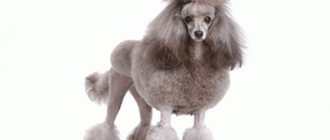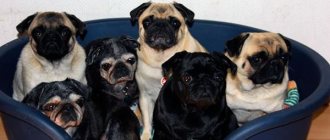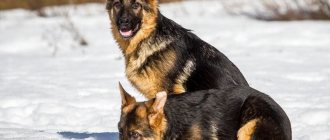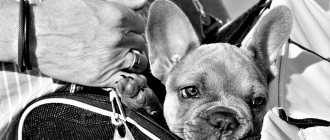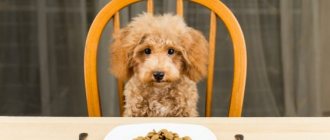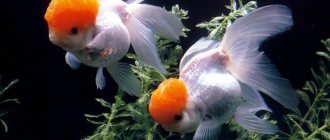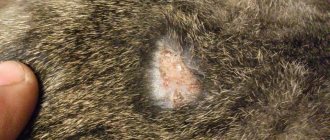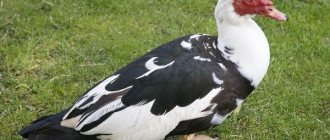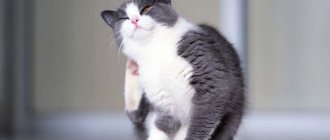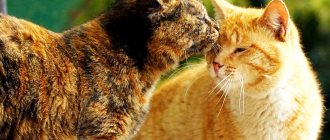The most comfortable apartment dog is small, non-shedding, intelligent and sociable, all of which are characteristics of the Toy Poodle. Having become familiar with the theory, many potential breeders doubt the veracity of what they have read. Those who decide to buy a puppy often end up with one or even two more dogs, since even a small “flock” brings only minimal inconvenience.
Performance evaluation and information
Mini Poodles are beautifully built: they are very beautiful and majestic. They love people, but do not like to play with other dogs - they are better off alone. These dogs are not intended for guarding premises or herding livestock; they need to be kept in the house, in a warm, cozy atmosphere.
After studying the description of the breed, you can find out what color toy poodles are, their height and weight, and how long these dogs live.
Breed characteristics:
- have an elongated, toned body;
- the wool is curled, very thick;
- long muzzle;
- the paws are straight, well-developed muscles, and have soft pads;
- the color can be two-color or one-color (the color of adult dogs can be brown, peach, white, black and gray, without various inclusions and impurities);
- ears are long and wide;
- height at the withers reaches 23-28 cm in a female, 25-28 cm in a male;
- the weight of an adult dog is 6-8 kg;
- live, with good care, from 15 to 18 years;
- do not shed and do not emit an unpleasant odor.
Sizes and types of poodles
Based on the height of the dog, all poodles are divided into large (45-60 cm at the withers), small (35-45 cm), dwarf (28-35 cm), toy poodles (24-28 cm). The main characteristics in the breed description apply to all of these varieties, but each of them also has its own characteristics.
You might be interested to know the top 10 breeds of large and medium sized dogs.
Big
The largest and most graceful representative of the breed. Such dogs are also called royal dogs and, taking into account their appearance, it is difficult to argue with this. Large poodles are not as energetic as their other relatives, which is largely due to their large weight (up to 32 kg) and significant growth. However, like the others, they are easy to train, get along well with children, and their fur practically does not cause allergic reactions.
If the poodle senses danger, it may well show its guard qualities. They can be kept both in a large house and in apartments, but the main condition remains regular walks and constant physical activity. With good care, large poodles can live up to 15-18 years.
Important! The growth norm for the breed is prescribed in the FCI standard, but at the same time, the English and American standards do not indicate the maximum height value, which means that large poodles will also include dogs with 70 cm at the withers. At the same time, prize places at at exhibitions, they often go to representatives of the breed whose height at the withers corresponds to 58-65 cm, taking into account the gender of the animal.
If you are worried about a lot of wool in the house, then don’t. Like smaller representatives of the breed, large poodles are regularly groomed (English Saddle and Continental haircuts are often used), as a result of which you do not have to constantly brush your pet or come across hairballs throughout the house.
Small
In many ways, the small (or medium) poodle is similar to its “big” brother, except that it is more mobile and active. These dogs have the same temperament as representatives of the larger species, they are people-oriented, have high rates of obedience, and their speed and agility allow them to take prizes in agility and flyball competitions.
Check out the rating of the 10 most popular categories of dogs for apartment living, as well as the rating of the kindest breeds
They are excellent for keeping in apartment conditions, but also require regular physical activity (in this case, moderate intensity). Under good conditions they can live up to 12-15 years.
The American Kennel Club has recognized the Small Poodle as a separate breed, although many believe that it is just a variety with a smaller size (no more than 45 cm at the withers) and weight (about 6-8 kg). It must be said that it was precisely the small size and the same high intelligence that became the reason that this breed can be found more often than others in circus performances.
Did you know? The name of the breed comes from the German expression
“ pudel-nass ” , which can literally be translated as “wet to the skin.” True, in the French version the name of the breed may sound like “caniche from cane” (duck), which is associated with their original hunting purpose.
Dwarf
Representatives of this variety are even smaller than the previous ones, since their height does not exceed 35 cm, and in most cases reaches only 30 cm. Weight can fluctuate between 5-7 kg. When describing the external characteristics of a dog, the almond-shaped eyes, which are usually set slightly askew, deserve special attention. The short back should be straight, that is, not convex or arched, with a strong and short loin. The belly, like that of other poodles, is moderately tucked. Despite their small size, the muscles of both pairs of limbs are quite developed, the paws themselves are straight and parallel.
In terms of personality, toy poodles are more domestic dogs that are emotionally quite dependent on their owners. These are very kind and gentle pets, absolutely devoid of any aggression. They don't trust strangers, but this is largely due to their introversion and attachment to their family. At a young age they bark a lot, but the older the dog gets, the calmer it begins to behave.
You can take care of your dog using a clipper, furminator and grooming machine
It is interesting that tan dwarf poodles and harlequin-colored animals are recognized only in Russia, while in other countries the breed standards are black, gray, brown, white and apricot. In any case, the appearance of the dog largely depends on the haircut chosen by the owner.
Toy
Even with such modest sizes (no more than 28 cm), these dogs were originally bred as hunting dogs and were used to carry downed birds or small animals, however, there is still no consensus on the exact origin of the toy poodle. Unlike the previously described dwarf ones, bright red, brown or chocolate representatives are often found among toys. The weight of these poodles is on average 5-6 kg, but the physique of the babies is just as strong and graceful, especially in the lumbar region, paws and tail. Life expectancy is about 18 years.
Like other varieties, these small dogs are very devoted to their family, but perhaps more than others they need daily expressions of affection and love from their owner. Mental abilities are very well developed, thanks to which toy training occurs in record time. True, one cannot ignore the high natural curiosity of such pets, because constant, sometimes excessive, activity makes animals a source of noise, which in a city apartment can cause complaints from neighbors. In other respects (rhythm of life and habits), the toy poodle is quite suitable for keeping in small spaces, but you will also have to walk with them as often as with other species.
Important! Social contacts with their relatives are not as developed in small dogs as in larger poodles, so you should not expect a violent reaction from your pet to the neighbor’s Pekingese. When meeting another dog, he will most likely act very cautiously.
Origin of the breed and purpose
There are several theories about the origin of the decorative dog.
The first and most popular theory is that the dog was brought from Germany to France 500 years ago. In those days, this breed was actively used for hunting game (preferably ducks and partridges). Hunters valued the dog for its intelligence and excellent sense of smell.
For convenience, the poodle's hair was cut, so it swam faster and took game out of the water. In 1886, supporters of this breed founded the Toy Poodle Club.
Did you know? The word "poodle" comes from the German phrase "pudel-nass", which means "soaked to the skin."
The second theory of the origin of dogs was put forward by Swiss researcher Rosa Engler. According to it, the homeland of poodles is Central Asia, and they were spread around the world by Phoenician sailors, who brought decorative dogs to the cities of the Mediterranean.
Description of the breed
The Cockapoo breed standard is not particularly tied to the size and weight of the hybrid. The main parameters of the new breed are health, temperament, gentle and friendly character. According to physical parameters, cockapoos are divided into 4 types:
- dwarf – weighing up to 3 kg;
- mini – weighing from 5 to 8 kg;
- toy – weighing from 3 to 5 kg;
- maxi – weighing from 9 to 30 kg.
Dogs of this breed have a characteristic scissor bite, a square body, and large, intelligent eyes. And most importantly - non-shedding, odorless wool that does not cause allergies. The color of a cockapoo can vary, as can its weight with height. The most common colors are white, milky, beige, black, brown, peach, and silver. But there are also colorful individuals.
Before the development of the breed standard in the 90s, cockapoos were bred in two ways:
- crossed an English cocker with a mini poodle;
- adult cockapoos were mated.
Important! A pure breed is considered to be a mating of an adult Cockapoo, not a Cocker Poodle cross.
In appearance, the new species is more reminiscent of a poodle. He has silky wavy or curly fur, high paws, and an intelligent look. The shape of the head and ears, as well as the friendliness and flexibility, are more reminiscent of a spaniel.
Representative of the cockapoo breed
Appearance - standard requirements
All types of poodles have the same external characteristics, except for height. The main characteristics of a standard toy poodle are:
- noble posture;
- well-defined, pointed chin;
- thick curled fur;
- long ears hanging along the head;
- expressive eyes;
- single-color or two-color color, without other impurities
Differences from a miniature poodle and a mini toy poodle
The differences between a miniature poodle and a toy poodle are minimal, the only difference being their height. The dwarf breed reaches a height of 28 to 35 cm, the toy poodle - 28 cm. Everything else - color, habits, diseases, life expectancy - is the same for these dogs.
Small dog breeds also include Norwich Terrier, Griffon, Lhasa Apso, Chihuahua, Japanese Dwarf Spitz, King Charles Spaniel, Yorkshire Terrier, Jack Russell Terrier, Papillon, Biewer York, German Spitz, Welsh Terrier, Maltipoo.
Dog Breeds Similar to Poodle
Among the poodle-like dogs, two groups can be distinguished: those similar to large poodles and small ones.
The first group includes:
- Black Russian Terrier;
- White South Russian Shepherd;
- Bobtail;
- Irish Soft Coated Wheaten Terrier;
- Giant Schnauzer.
The second group includes:
- Maltipoo;
- French lapdog (Bichon Frize);
- T-cap;
- Shih Tzu.
Personality of a mini poodle
This breed has an ideal character. They are calm, affectionate, cheerful, gentle, moderately playful and understanding.
Did you know? The French ruler Marie Antoinette adored poodles, they became respected favorites at the royal court.
Of course, the pet’s character is influenced by the owner’s attitude towards it. The owner of the breed must play and care for the four-legged companion. Only with constant contact with a person will a poodle be affectionate and obedient. Feeling indifferent, he becomes distant and fearful.
Character and behavior
Cockapoo dogs have an amazingly sociable nature. They gladly take part in games with children, are friendly with all family members - adults, children, and the elderly, and will never offend other four-legged members of the family. They will try to establish friendship with the new pet, even if they have never met him, will share the attention of their owner with him, and will not be jealous.
Let's play together
The poodle-spaniel mix is a very smart, curious animal with high intelligence, he cares about everything. He loves to run, play, and have fun. This is a true friend and devoted companion. If the dog is bored, he will persistently follow on the heels of the owner, demanding attention, not receiving what he requires, and may be offended for a long time.
Which owner is it suitable for?
Poodles are active, playful and lively dogs. They require constant play, training and walks. Without an active lifestyle, dogs will become irritable and distant.
Dogs do not tolerate rude treatment and indifference. They need constant praise, care, love and affection.
The dog owner must be:
- active and mobile;
- soft;
- consistent;
- calm;
- caring.
This pet is primarily a lap companion dog.
It is not intended for home security or hunting. If you are not confident that you can provide your poodle with constant care, companionship, praise and walks, get yourself another dog, as this breed requires refined communication.
Training and training the dog Marie Antoinette
Toy poodles are easy to train; thanks to their good memory, they easily remember commands and can repeat them.
Dogs of this breed need to be trained from childhood. Some owners wait until the pet is one year old, thereby missing out on a great time for training. Toy poodle puppies are very playful and active, so learning commands should begin at an early age, preferably from four months.
Did you know? Toy poodles are most often used in circuses and other entertainment shows , as they are excellent performers and assistants to circus performers.
Only patience will help you raise an obedient dog. Pets do not tolerate aggression, screaming and irritation. They pass through themselves the entire emotional flow of the owner.
If you try to train a dog using force, then the opposite result awaits you; the dog will become cowardly and disobedient.
During training, praise your pet - he feels it and will give a positive result. Training should take place in a peaceful and calm environment.
Your actions must be consistent, clear and skillful. Do not learn all the commands at once; only after successfully using one command, start learning the second.
The basic command is “Place”, start with it. The puppy must know where his place is, where he can rest and will not disturb his owners.
Once the puppy has learned this command, you can teach him to sit, lie down, fetch things, etc. Bringing joy to your owner is the main job and fun of toy poodles.
Poodle
Unlike the more versatile schnauzers, all poodles belong to the same hypoallergenic breed. This includes large standard, toy and miniature versions, so you can choose any size doggie. Super smart poodles are very easy to train, making them one of the most popular dogs in the United States. As for this fancy "poodle clip," the traditional cut protects the water-loving dog's joints and vital organs while swimming, and also looks damn adorable.
How to choose a puppy and its price
For your own confidence, it is better to buy toy poodles from nurseries. If you decide to buy a four-legged friend from your own hands, then to make the right choice, focus on the external characteristics of the puppy, namely (as an example, let’s take a puppy who is 4-6 weeks old):
- the head is set nobly. The skull is oblong and flat on the sides;
- has an elongated muzzle and a well-defined chin;
- has dark oval eyes. The eyelids should be dry. There should be no wet streaks under the eyes;
- The ears are long and wide enough to reach the nose. The ears should be soft to the touch;
- At this age, the teeth should already be fully visible, six incisors on top and bottom. The fangs are just breaking through (the lower fangs look to the sides);
- The length of the neck is equal to the length of the head. The body is compact, dense, the loin is strong, the back is wide;
- the tail should not fall over the back;
- The front legs are straight, the hind legs are arched, the dog stands firmly and confidently. It has elastic muscles and massive limbs.
The pricing policy is varied; on the supply market you can buy a toy poodle for $500-1200. The criteria for setting prices are different: famous parents, unique color, excellent external characteristics, etc.
Living and maintenance conditions
Marie Antoinette's favorites are picky about care and maintenance. Every owner should be prepared for constant bathing, haircuts, and walking their pet. Poodles are not yard dogs, they are small apartment dwellers who, when cared for, are more like people than four-legged companions.
When caring for a dog, you need to know whether dogs need shoes, how to sew overalls, how estrus and mating occur in dogs, how to choose a clipper, the basic rules of agility for dogs, whether dogs can have dry food.
Difficulties of care
Toy poodles are difficult dogs to care for. They need to be constantly bathed, combed, nails trimmed, and teeth taken care of. They require constant attention, care, affection and praise.
With all these shortcomings, you cannot find a better companion and friend: they are smart and understanding.
They need constant care, these dogs are like little children. Yes, there is a lot of trouble, but also joy. If you look at it globally, the only disadvantage of the breed is its soreness.
Wool and haircut
Poodles have a unique coat. The coat is evenly distributed throughout the pet's body, that is, on the muzzle and in the ear canal the hair reaches the same length as on the tail. The coat does not shed; people with allergies to wool can own such dogs.
The poodle's coat is very unique; its external characteristics are similar to sheep's wool. Although these dogs do not shed, they replace their baby hair with an adult one. The process of fur change occurs at the age of 8-10 months.
Important! The owner must monitor the process of changing the coat and constantly comb it out. If you do not comb out the dying hair, the dog will become covered with thick felt, which prevents the growth of new hair. In such a situation, the dog needs to be shaved.
Caring for the appearance of the coat falls entirely on the shoulders of the dog's owner. A poodle is physically unable to lick its long, curled fur. Grooming is the main tool for caring for a poodle's coat.
There are different types of Toy Poodle haircuts. The main ones are the lion haircut and the modern haircut. These haircuts are considered universal and can be easily reproduced even at home.
Wool is cut using both scissors and mechanical clippers. Before grooming, buy and comb your pet well. Afterwards, carry out the preparatory work (cosmetic haircut), namely, cut off the hair in the area of the muzzle, genitals, tail and limbs with scissors.
Important! Toy poodles' fur mats easily into felt. There are special farms that raise this breed specifically for its wool, because it can be used to make warm and pleasant clothes.
Only after this proceed to the main haircut of your four-legged friend. The nozzle of the machine should not be less than one millimeter. If you are not confident in your abilities or you can’t do it, do not torture the animal, but take it to a professional.
Ears, eyes, teeth, claws
Toy poodles are clean animals and appearance is very important to them. The owner of a dog must take care of its appearance, clean its ears, eyes and teeth, cut its nails and much more.
Bathing
Unlike other breeds, poodles love to take baths and undergo special beauty treatments. This pet needs to be bathed at least once a month; the ideal option is to take bath procedures once every two weeks.
When bathing, use shampoos designed for dogs with long hair. The bathing process consists of the following stages:
- Before swimming, comb out all the tangles, because after that it will be much more difficult (you can use an anti-tangle spray).
- Wet your poodle with warm water up to the skin.
- Dilute the shampoo with warm water.
- Using light massaging movements, distribute the shampoo over the dog's entire body.
- Afterwards, rinse the shampoo well.
- Repeat the procedure of applying shampoo and rinsing again to completely rinse the coat.
- Apply a special balm to wet wool, which prevents the appearance of tangles and also saves the wool when drying.
- Dry your dog with a hairdryer (poodles are very afraid of freezing, dry them very carefully, without missing a single area of hair on the body). When drying, comb it against the grain.
Puppies are very emotional, playful, restless.
Walks
Toy poodles are very active and mobile. They need to be walked often, so they spend their inexhaustible energy and, as a result, are less mischievous and nervous.
Games and physical activity have a good effect on the health and psychological state of dogs.
Four-legged friends do not like to play with representatives of their kind; they only need human communication and attention.
Important! Toy poodles have a poorly developed undercoat, so in winter they need special clothing.
The winter walking time for dogs is reduced; it should not exceed 20-30 minutes, four times a day. If you see that your pet is clenching its paws or trembling, take it home. If the air temperature is -10°C, it is better to stop walking for a while.
The condition of the coat affects the duration of the walk. If a dog has cropped fur or tangles, then it freezes much faster than a pet with well-groomed and uncut fur.
Nutrition
Mini poodles should have a varied diet. The dog's body needs both animal and plant foods.
Your pet's diet should include:
- Meat and fish
Beef is the main food for poodles. You can give boiled meat, or raw meat, after cutting it into small pieces. Minced meat is given only to puppies or sick dogs. Depending on the weight, the dog should consume from 30-400 g of meat per day.
Boiled offal (legs, trimmings) should also be included in the pupil’s diet.
In general, meat products should make up 2/3 of a dog’s diet. Fish, an equally important and necessary component of proper nutrition, can replace meat. Poodles should be given it 1-2 times a week, but at a rate of 30-300 g per day. Remember that freshwater fish must be boiled, while sea fish is usually given raw.
Important! Puppies up to three months old can only digest boiled fish, cleaned of scales and giblets.
- Eggs
Eggs are a storehouse of protein and minerals. Feed one hard-boiled egg to your poodle 1-2 times a week. Crumble it well before using.
- Milk and cheese
Dairy products are easily digestible and nutritious. They are served raw. A toy poodle can consume 0.1-1 liters of dairy products per day.
- Plant food
Cereals are a fundamental part of a pet’s diet.
The cereal is boiled until it becomes a thin porridge. Basically, dogs like to eat rice, buckwheat, and oatmeal porridge, but they disdain pearl barley and barley. The daily intake of plant feed should be 100-500 g per day. Calculate proportions taking into account the weight of the poodle.
- Vegetables and fruits
Vegetables and fruits are the most fortified food.
They will not become the basis of the dog's diet, but will be a good addition to the main dishes. Add fresh carrots, cucumbers, tomatoes, sauerkraut, spinach, beets and other products to your pet's food. Before serving, all vegetables and fruits should be finely chopped.
The main thing is not to overdo it with the consumption of vegetables and fruits: 200-300 g per day is the ideal amount of vitamins for a poodle.
Did you know? Many dog breeders include nettles in their dog's diet. The plant is able to awaken the appetite, providing anti-inflammatory, wound-healing effects, and has a good effect on the digestive system. Before serving, the nettle should be thoroughly chopped and doused with boiling water to avoid burning.
- Water
You need to have a separate water bowl for your dog. The bowl must have its permanent location. Your pet needs 24/7 uninterrupted access to water.
Dogs drink 1.5 to 2 liters of water per day.
In hot weather or when feeding dry food, the need for water per day increases. Try to monitor your pet's diet. If he doesn't finish all the food in the bowl, reduce the amount.
If your pet licks the empty plate after eating, increase the amount of food. The food should not stagnate in the container - it may spoil.
Each dog is individual; the owner himself selects the diet for his pet based on body weight, age, illness and other fundamental indicators.
Color variations and appearance
But many breeders who like the Maltipoo breed are also interested in color and coat type. This is worth talking about at least briefly.
There are generally three types of wool:
- Smooth, silky. The most expensive and popular type. This wool is easy to care for and beautiful.
- Curly wool. Inherited from a poodle. It causes quite a lot of trouble and, if not taken care of, quickly falls into tangles.
- Coarse wavy coat. The rarest, but not too beautiful, so these puppies are sold at the lowest price.
In general, among mestizos, color is always a lottery. Even the best breeder cannot say for sure what the newborn Maltipoo puppies will be like. The colors commonly found are silver, blue, red, brown, peach and cream. Black and white maltipoos are quite common. But it is also possible that they have a combination of several colors.
